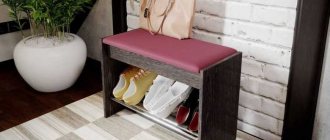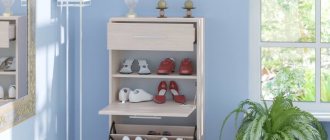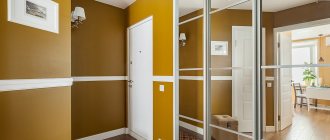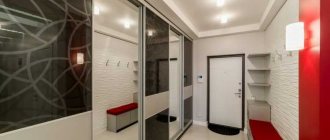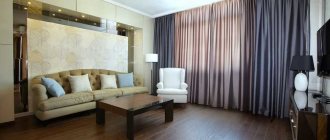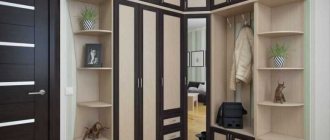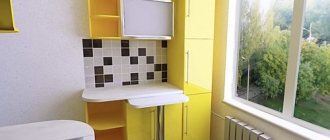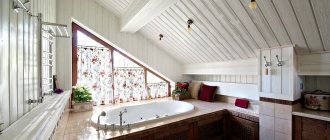Don't blame the mirror if you don't like the reflection. First, make sure it casts you in the best possible light with properly selected and installed fixtures. In the hallway and corridor you can only dream of natural light, so a lone chandelier under the ceiling will not be enough and at a minimum you will need an additional sconce. Various lighting scenarios, spot lighting of mirrors and other key interior elements are a guarantee that you will be greeted from the doorstep by a joyful and cozy home, and not a dimly lit cave.
Bright interior with sconces
Hallway lighting rules
There are several rules that will help you choose lamps for your hallway correctly and without problems.
To make installation of the lamp take less time, plan in advance where it will be located, even during the renovation. Conduct the wiring in advance, disguise it, install sockets and switches.
Use the services of a professional electrician unless you are an expert in this matter yourself.
Before you go to the store, think about how many light sources you need and where they will be located.
The level of illumination in the hallway should be correlated with the illumination of the entire apartment.
If you buy several light sources, choose lamps from the same collection, so they will definitely be combined with each other. In the catalogs of large stores you can find photos of sets of lamps for the hallway; make your choice based on them.
If there are stairs, niches or thresholds in the hallway, be sure to light them to avoid injury.
Choosing the right one
Even if you decide to stick with classic ceiling lighting (Armstrong ceiling lights, for example), consider adding wall-mounted options to your interior.
- Firstly, even one wall lamp can change the appearance of the hallway for the better.
- Secondly, this is the best way to create an atmosphere of comfort and mystery, which is more appropriate in the hallway than anywhere else.
- Thirdly, such lamps perform important functions.
Below we will consider their main varieties.
Classic sconce
Design
Sconce is the most popular model. Looks great directly next to the door and near the area that needs to be emphasized: for example, to the right and left of the picture.
The light can be quite powerful, but an important requirement is that it should not hit the eyes. In the corridor, preference for sconces may be given not so much for functional reasons (ceiling lamps also cope with various functions), but for reasons of creating coziness and a special atmosphere.
Make sure that the walls are in perfect order if the sconce fits tightly enough to them. Scratches and peeling wallpaper are unacceptable.
Spots on the leg. Based on the “on a leg” feature, they can be classified as sconces, but we still put them in a separate category, since they are attached not only to the wall, but also, for example, to a bedside table with keys and a table. Also, unlike sconces, such lamps exclude design delights. This is a godsend for fans of minimalism or those whose hallway does not require additional decorations.
Tablet lamps. We will stick to this name to distinguish it from sconces, but most often they are simply called “wall lamps.” Inconspicuous mounting and soft diffused light create a pleasant mysterious effect. And if you add a motion sensor to the device, then at night you won’t have to sneak around in the dark, for example, to get a glass of water or rummage around the walls in search of a switch.
“Tablets” are not only round or square in shape. Choose a lamp with outlines that are in harmony with the rest of the interior. Think about what is better to add: severity and clarity, or softness and smoothness.
Triangular wall lamp in the hallway
An elegant sconce in the shape of a shell can bring a little romance and lightness to the interior.
Purpose
Additional lighting to the main one. It is ideal if the hallway is equipped with both general and additional lighting. The overall look can be created with both ceiling and wall lamps. In the second case, they should be located above human height and be powerful. Additional lighting highlights areas in which certain activity occurs (mirror, table, dressing room), or the best parts of the interior (paintings, figurines, vase, etc.)
If the size of the hallway allows, designers advise mentally dividing it into three zones. One sconce should be placed directly next to the door, the second above or near the mirror, and the remaining wall lamps should be placed in the common area.
Correction of space geometry. Some hallways have an irregular shape, which, especially if they are small, creates an unfavorable impression on guests and spoils the mood of the owners every day. By placing several sconces on short legs or tablet lamps along the wall, you can visually extend one of the walls.
also completely abandon the main lighting and use the same wall lamps to create two or three bright accents. If the hallway has a very high ceiling (we are talking about a house rather than an apartment), and because of this the space seems empty, you should place several sconces on an imaginary line exactly between the floor and the ceiling.
Decoration. This function is relevant for those who are alien to minimalism. Fortunately, there is now a huge selection of decorative sconces: in the shape of animals, candles, lanterns and even people.
When placing candles and vases on the hallway shelves, think about whether sconces or table lamps in the shape of vases and candles would look more beautiful in their place.
Material
If the task is to make the hallway brighter, give preference to crystal and transparent glass. For calmer lighting, choose lamps with lampshades made of plastic, textile, metal or wood.
Types of lamps
Several types of lighting fixtures are traditionally used in hallways:
Spotlights in the hallway. They are inexpensive, take up little space, and provide a lot of light. Mounted in suspended ceilings or plasterboard ceiling boxes.
Wall lamps in the hallway. Depending on the model and manufacturer, they can be either budget or expensive. Sconces take up little space on the wall; they are usually hung next to the mirror.
LED strips. Often used as additional lighting along with other light sources. They are placed along the ceiling (hidden in a plasterboard structure), along cabinets, shelves or mirrors.
Spots are also often chosen as a lamp for a mirror in the hallway. Spots are rarely enough to illuminate the entire hallway; they are used in conjunction with other lamps.
Chandeliers are usually hung in spacious hallways. However, a small flat chandelier can be used as a central light source even in a compact hallway.
Not just a chandelier. Additional lighting and hanging of mirrors depending on the layout
The height of the sconce for the hallway is usually 180-190 cm of the floor, and the chandeliers are at least 210 cm. Only the use of additional built-in lighting, floor lamps and sconces complete with overhead lighting and skillful placement of mirrors will create a truly harmonious image of the space.
Important:
do not be afraid to go overboard with the number of lamps in the corridor and hallway.
In a small room without windows, too much light is better than too little. Think carefully about how to choose a chandelier. Mirror lighting in the hallway
Lighting a spacious corridor
A single chandelier in the geometric center of a large hallway can become a decorative accent of the interior, but not the only source of lighting. The larger the area, the more pressing the issue of light zoning, visually separating the dirty area at the entrance from the rest of the space.
Large entrance hall in classic style
A niche or opening between cabinets can give an interesting effect if you place a small banquette at the bottom and sconces at the ends opposite each other. On the back wall you can hang an impressive mirror or a light box (frosted glass behind which powerful lamps are installed). This will create an interesting play of light and shadow, additional architectural volume and works equally effectively for large and small spaces.
Light in the hallway-tiny
In a tiny hallway, it is important to coordinate the furniture arrangement plan with the choice of specific lamps. They should not touch or interfere with the opening of cabinet doors, and in the entrance area, where people will inevitably wave their arms while undressing, it is important to ensure that no one touches the sconce cord or low chandelier.
Mirror in a small hallway
The more light there is, the more spacious the room will seem, so it is important to illuminate dark corners using sconces, floor lamps or built-in lighting along the baseboard. It is better to choose large mirrors, without interruptions and small glazing.
Illuminated mirror in a niche
Important:
designers are in solidarity with the masters of the ancient Chinese teaching of Feng Shui.
Choose solid mirrors, especially in small spaces. Make sure they are free of dust, fingerprints and chips. Suitable here
×
Mirror with shelf oval in gold frame Circle
9 640 ₽
9,640 ₽ buy
Mirror with shelf in the hallway
Illumination of a square and L-shaped corridor
In a square hallway, it is important to find a part from where at least some light enters the room, for example, from a window in the living room or kitchen. It is opposite this wall that you need to hang a mirror and sconce so that the reflection works as an additional source of natural light.
Mirror with built-in lighting for the hallway
The L-shaped layout of the hallway automatically divides the room into two parts, so it is important to take care of the lighting of each of them separately. It is better to place the mirror and sconce further from the entrance area.
A narrow and long corridor is not a death sentence
Sconces that illuminate the walls as much as possible will help to visually smooth out the tunnel effect and are the main allies in correcting narrow and long spaces. Another effective technique: “light at the end of the tunnel.” At the end of the corridor there should be a sconce on the wall, the light of which will be a beacon for the eye, and next to it a large painting, a bright piece of furniture (chair, console table, floor vase). An object that stands out will attract the eye and the corridor will no longer seem so long. A mirror can also become a focal point, but with caution: a floor-to-ceiling model can elongate the space more.
Suitable here
×
White ceiling lamp gold D20x150 cm 60GD-9137P/S
8 000 ₽
8,000 ₽ buy
Lighting a narrow and long corridor
Important:
multi-level cornice ceiling lighting makes sense if their height is higher than standard. This will reduce the disproportion of a cramped but elongated space.
Zoning with light
A set of several different light sources will help divide the hallway into functional zones.
Entrance door. This part should be well lit because This is where the hosts and guests undress and take off their shoes. Above the door in the hallway you can hang lamps on the wall or place a couple of spots above it.
Wardrobes and hangers. The open storage system in the hallway can be illuminated using an LED strip in the cabinet itself.
Corridor. A narrow corridor is illuminated using one or two paths of spots.
Mirror. You can highlight this area using two or more wall sconces on the sides of the mirror, a module of 2-3 spots above the mirror, or a powerful LED strip around it.
Armchair, couch or pouf. If your hallway is large enough to accommodate a seating area, you can place a floor lamp on a thin leg next to it. This will make the hallway more comfortable.
Lighting in a small corridor
Let's talk about what kind of lighting is usually used in a small hallway:
- local - to supply light to certain places;
- general - as lighting for the entire corridor;
- decorative - as illumination of interior decorative details.
The integrated use of the listed light sources will allow you to place emphasis on significant interior details and correctly distribute lighting in the hallway, the photo is an example of this.
Lighting and interior style
To choose which lamp to choose for the hallway, you need to start not only from its technical characteristics, but also from its style. The lamp must match the chosen style of the hallway interior.
For a modern style, opt for simple lamps or hidden spotlights. Choose lamps with bright daylight in a neutral or cool shade.
Lampshades made of glass and fabric are suitable for a loft-style hallway.
Retro hallways need lamps with lampshades made from natural materials with a soft, warm light. Choose floor lamps, chandeliers and wall lights. Spots and LEDs are not suitable for classic interiors.
Illuminated mirror – good mood for the whole day
A mirror reflects a specific moment in time and space. How you see yourself in it before leaving the house is how you will feel for most of the day. Therefore, it is important that you like the reflection and create a positive mood. Leave a cosmetic mirror that shows the slightest imperfections of the skin and a bright directional light for the bathroom.
×
LED wall lamp Odeon Light Nicco 4033/21WL
13 440 ₽
3,091 ₽ buy
Unusual metal sconce
A flat ceiling light will not give a three-dimensional living reflection, which is why it is so important that there are several different lamps in the hallway, selected taking into account each other. The combination of diffused light from above, directed from a sconce on the wall and the use of neutral-colored light bulbs guarantees eye-pleasing lighting and reflection that does not look like a pale imitation of the original.
Design of large mirrors for the hallway
Important:
it is important to consider the placement of lamps at the stage of rough repairs in order to connect the wiring to the location of the future sconce above the wall mirror. Exposed wires on the walls will not fit into every interior style.
How to place lamps
When choosing a place for each lamp, you need to make sure that it will not interfere with your dressing and you will not catch it when opening the front door or closet.
There should always be 2.1 m or more from the bottom of the chandelier to the floor. A person who raises his hands when putting on a jacket or taking off a hat should not touch the ceiling light. Therefore, it is better not to hang a chandelier directly above the door.
When choosing wall sconces, make sure that there is at least 80 cm between them and the opposite wall. Also, sconces in the hallway should shine up or down; direct light from sconces or spots can be blinding.
If you use bright wall lights, hang them not at eye level, but 25-30 cm higher.
What lamps are best for the hallway
Some recommend choosing maximum illumination, while others believe that moderate light is sufficient in the hallway. According to SNiP standards, the illumination of the hall and corridor should be at the level of 50 Lux.
1 lx = 1 lm/m2
To make it easier for you to imagine, we offer the following comparison:
250lm = 20W incandescent lamp = 5-7W fluorescent lamp = 4-5W LED lamp.
The standards indicate a preferred threshold below which performance should not fall. Lighting is one of the factors that can have various psychological effects on a person. For example, a lack of light can be depressing, while too much light can be annoying and even provoke aggressive behavior.
Another factor that requires attention: since we are putting clothes and makeup in order in the hallway, we need the color perception to be consistent with natural daylight. A typical example is women purchasing lipstick. Bright, cool white light makes colors appear dull and skin pale. Once on the street, women often discover that in reality the shade of lipstick is not the same as they saw it when the window was illuminated.
Lighting in the hallway with suspended ceilings
Nowadays, many apartments have suspended ceiling systems installed. The glossy surface allows you to visually enlarge a small corridor, and it also becomes possible to create unusual lighting.
If you plan to install a suspended ceiling with spots or LEDs, remember a few important rules:
- The power of the light bulbs should not exceed 35 Watts; more powerful lamps can become very hot and melt the ceiling;
- When purchasing spot bulbs, buy several identical bulbs as a spare so you don’t live in the dark while you buy a new one;
- Choose those lamps that are mounted outside. They will be easier to replace or repair if necessary.
The meaning of light in the interior
Dark and poorly lit rooms look more cramped. Bright lighting helps to visually expand the space. A bright hallway, being small in area, will become more comfortable when powerful lamps or additional lighting sources are used.
Large mirrors, glossy surfaces and decoration in light colors will help make the hallway cozy - all of this has the ability to additionally reflect the incident light, increasing its brightness.
In most of the old apartments, the hallways were small and narrow. For such premises, the issue of additional lighting becomes paramount. Otherwise they look very uncomfortable.
Criteria for selecting lamps
Harmony with the interior. The lamp must be combined with the design of the room in shape, color and style.
Proportionality. The lamp should be proportional to the size of the hallway and the pieces of furniture located there.
Installation method. Consider the installation method of the luminaire when choosing it. Thus, a heavy chandelier cannot be hung on a plasterboard ceiling, and spotlights cannot be installed on a concrete ceiling.
For plasterboard and suspended ceilings, it is important that the light bulb does not overheat. This parameter is also important for lamps located next to fresh flowers.
Use lamps with additional functions. Lamps with variable light temperatures and light sources with a motion sensor are very convenient for hallways.
A properly selected hallway lamp will make it not only a beautiful, but also a functional area of your home.
Ceiling lighting
Among the huge variety of lighting products for the ceiling, it is difficult to choose the most optimal model that will fit into the design of the room, correctly distributing the light source.
Types of corridor lamps for the ceiling:
- Advantages of halogen lamps
- Advantages of ceiling lamps
Rooms without windows
- Diffused as well as directional light sources;
- Reflected as well as direct lighting;
- Local or general lighting;
- Decorative or household use.
When deciding what lighting to use in the hallway, it is important to approach this issue comprehensively.
Also, do not forget that a thoughtful interior solution through lighting will allow the room to sparkle with unique colors.
In this case, the main thing is not to forget about practicality, safety and maximum convenience of the selected electrical appliances.
